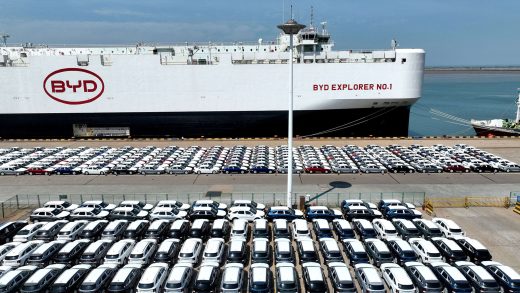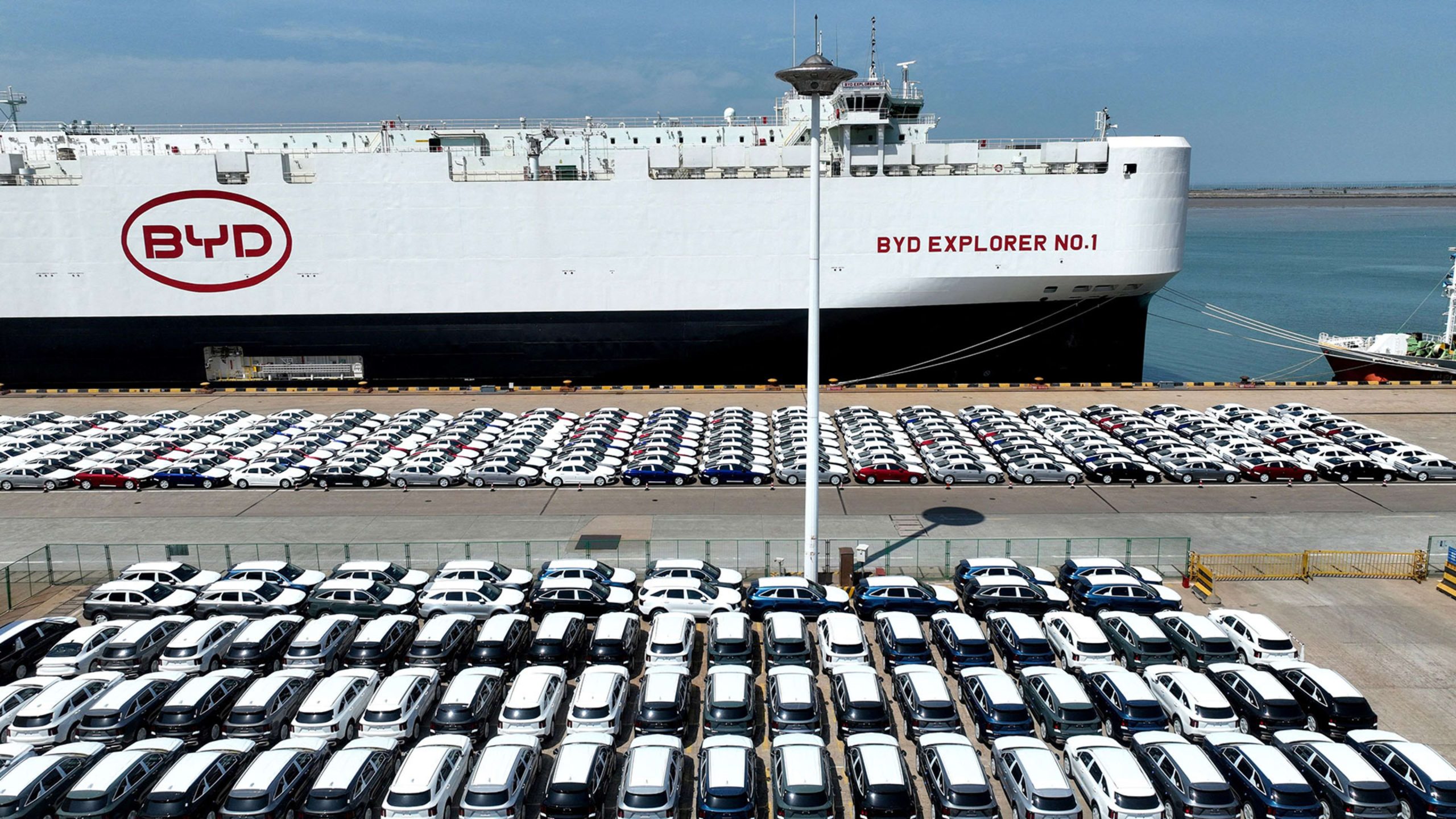China’s BYD automaker charges triple for its exports—here’s why
China’s BYD automaker charges triple for its exports—here’s why
The overseas upcharges allow BYD to make a profit not possible in the saturated Chinese market.
BY Reuters
U.S. and European politicians have raised alarms that their domestic auto industries could be destroyed by a wave of cheap Chinese electric vehicles. But so far, China’s top EV maker, BYD, has dramatically hiked export prices compared to what it charges at home rather than undercut foreign rivals.
The goal: to rake in hefty profit margins the automaker can’t get in China amid fierce competition.
In some foreign showrooms, BYD charges more than double—sometimes nearly triple—the price it gets for three key models in China, according to a Reuters review of the automaker’s pricing in five of its biggest export markets.
Take the BYD Atto 3, a compact electric crossover. In China, the midrange version sells for $19,283. In Germany, the little SUV is priced at $42,789—a price that’s still competitive with comparable electric vehicles in that market.
BYD did not respond to a request for comment. Company Chairman Wang Chuangfu in March told investors in a private meeting that BYD expects exports to help shore up profitability this year as a domestic price war weighs on its margins.
It’s common for automakers to charge slightly different prices for exports of the same or similar versions of a vehicle. But the sheer size of BYD’s upcharges for overseas markets is rare, said Sam Fiorani, vice president of global forecasting at market research firm AutoForecast Solutions.
“Globally marketed vehicles are usually priced in a narrow range,” Fiorani said.
The differential, in part, reflects cutthroat competition in China, the world’s largest auto market, where dozens of EV brands are waging a price war. BYD’s entry-level Seagull electric hatchback sells for less than $10,000 at home.
BYD’s big export markups also underscore the massive cost advantages that China’s EV industry has over foreign competitors. China’s EV leader has squeezed costs from every stage of production, from raw materials to batteries, land and labor, according to experts on China’s auto industry and battery-cost data provided to Reuters. In addition, Beijing has heavily subsidized both domestic and foreign brands selling EVs in China, where electric and plug-in hybrid vehicles accounted for more than a third of all new car sales last year.
This cost edge has foreign competitors nervous. Some U.S. and European automakers are calling for higher tariffs on Chinese EVs. BYD and other Chinese EV makers are already expanding in Europe but don’t yet sell in the United States, where they face higher tariffs and stiffer political resistance.
China’s domination of the global EV industry is on display this week at the Beijing International Automotive Exhibition, where BYD showed off two luxury models as part of a strategy to capture the premium market. Automakers are expected to launch 110 new EV and plug-in hybrid models in China this year, most from Chinese brands.
Hiking export prices gives BYD room to generate much larger profits per vehicle, experts in EV manufacturing costs told Reuters. But those margins also give the automaker enormous flexibility to cut prices if needed to grab market share abroad.
For now, Chinese automakers, led by BYD, are content to keep export prices elevated and reap the profits, said Ben Townsend, head of automotive at UK-based Thatcham Research, an industry-funded firm that works on safety issues with automakers, including some from China. He said Chinese EV makers often struggle to break even or squeeze out a small profit in their home market.
“They’re not looking to undercut the European market,” he said. “They are looking to make margin.”
BYD and other EV makers are also trying to shed the stigma of cheap Chinese products as they build global reputations and focus on maintaining strong resale values, said Bo Yu, Greater China country manager for UK research firm JATO Dynamics.
“Chinese automakers are in a brand-development phase,” she said.
Massive markups
Reuters reviewed pricing published by BYD or its dealers in five of its leading export markets — Germany, Brazil, Israel, Australia and Thailand—that commonly offered three of its most popular electric vehicles, the Dolphin and Seal sedans, and the Atto 3 SUV. In one case, Israel, the Seal was not offered.
Across those markets, the starting price for the BYD Atto 3 ranged from 81% to 174% higher than in China. Dolphin prices ranged from 39% to 178% higher, and Seal prices from 30% to 136% higher.
Comparing starting prices by market is complicated by regional differences in available trim levels. In some cases, entry-level exported vehicles examined by Reuters had slightly better equipment than the lowest-priced model in China.
In cases where apples-to-apples comparisons were possible at various trim levels, BYD’s export prices typically were still much higher than in China. For instance, the closest version of the Dolphin on sale in Germany, with the same battery range, sells for $37,439—more than double the $16,524 price tag in China. The upgraded Seal version sells for $48,139 in Germany, 59% more than its $30,317 China price.
By comparison, the Reuters analysis found that Tesla, which has a higher cost base than Chinese rivals, sells its Chinese-made Model 3 for only 37% more in Germany than in China, according to Tesla’s web site.
Automakers can face hefty costs in exporting cars. But BYD’s large export premiums are more than enough to cover them and deliver thousands of dollars in additional profit per vehicle, according to an analysis conducted for Reuters by A2MAC1, which disassembles cars for automakers to assess their competitors’ products.
Based near Paris, A2MAC1 examined the European version of the BYD Dolphin, which sells for about $35,000, and a China version selling for about $15,000.
The European Dolphin is slightly longer and has extra features, including a slightly bigger battery, a more comfortable suspension and additional sensors. Still, accounting for those upgrades, along with shipping and import taxes, A2MAC1 estimated that BYD’s profit margin on the European car was about $7,400 more than whatever it clears on the same car in China.
‘Bargaining power’
BYD has emerged as the dominant player in China’s electric-vehicle market. It’s now investing heavily and growing sales in markets worldwide.
Its 2023 exports of 240,000 cars accounted for 8% of its 3 million in global sales. But the automaker is swiftly adding new models and new markets and says exports should jump to 400,000 cars this year.
The Reuters review of Chinese EV model prices in Europe revealed that Chinese automakers often price their vehicles just slightly below or above legacy European rivals, while stuffing them with interior and tech features for which European automakers charge extra. The top version of the BYD Atto 3 in Germany sells for $42,789, just below the base model of the electric Opel Mokka at $43,652, but above the $41,298 starting price for a Peugeot E-2008.
Sometimes BYD shoots higher than competitors. It sells an upgraded version of the Seal in Europe for 10% more than the roughly comparable Tesla Model 3. In China, the Seal is priced at 6% less than the Tesla.
BYD has an advantage over legacy automakers with its vertically integrated supply chain. It makes almost all components of its cars in-house rather than farming them out to suppliers.
Lowering the cost of batteries—an EV’s most expensive component—has been key. BYD and other Chinese automakers and suppliers have spent the last two decades securing access to mines around the world to lock up critical battery minerals such as lithium and cobalt, said Keith Norman, chief sustainability officer at Silicon Valley battery startup Lyten. “They own the critical-minerals part,” Norman said.
Data provided to Reuters by market intelligence firm Benchmark Mineral Intelligence, shows the price for batteries in China to be around 18% lower this year than in Europe.
A giant company like BYD, which makes its own batteries, can drive its costs even lower by negotiating volume discounts across the battery supply chain, said Benchmark analyst Roman Aubry.
Chinese automakers are helped by affordable land—often subsidized by local authorities—and benefit from cheaper electricity and labor. They can also build plants in China in as little as a year because they face fewer regulatory hurdles than in Western countries, according to Mark Wakefield, head of the global automotive practice at AlixPartners, a New York-based consultancy.
That means Chinese automakers’ capital investment is far lower per vehicle, “and you make more money,” he said.
—Nick Carey and Ben Klayman, Reuters
(26)



